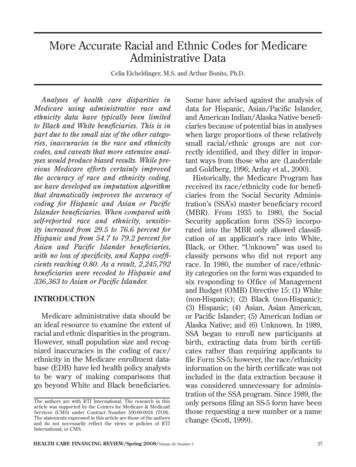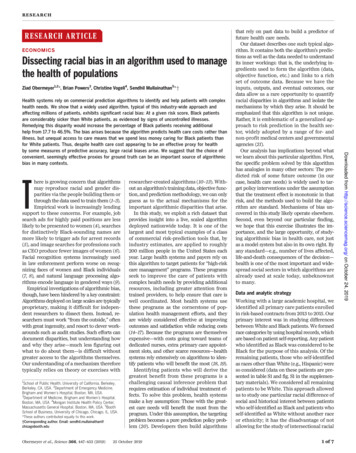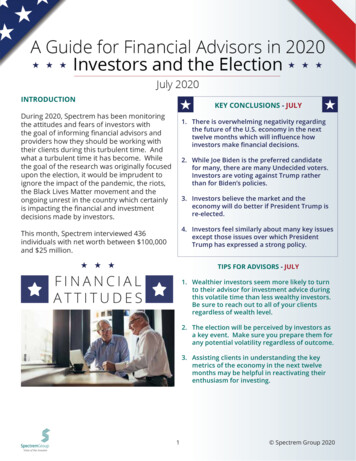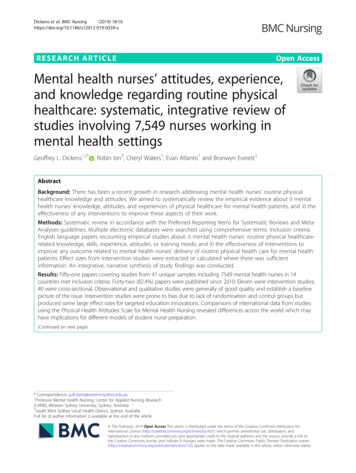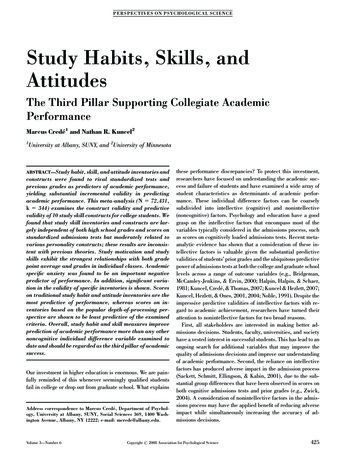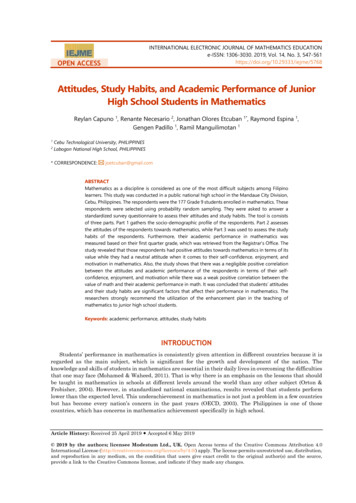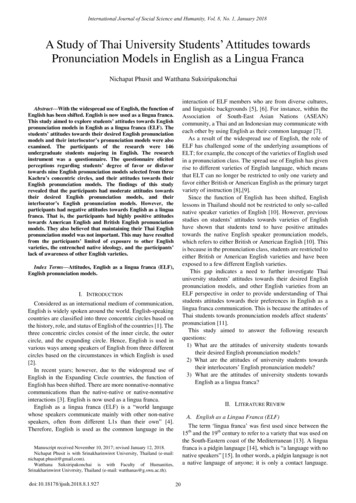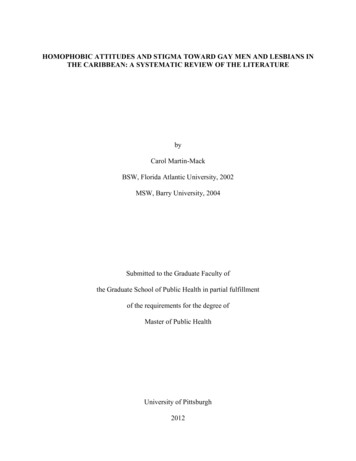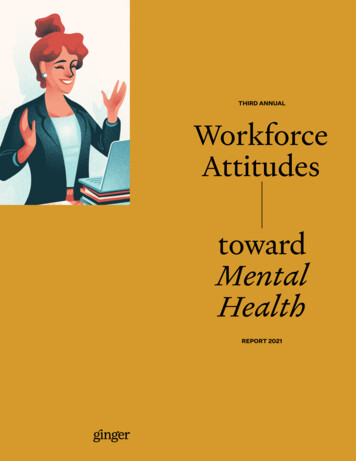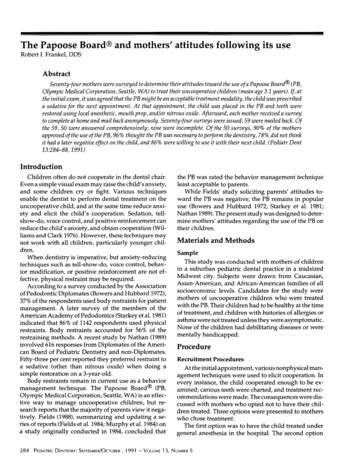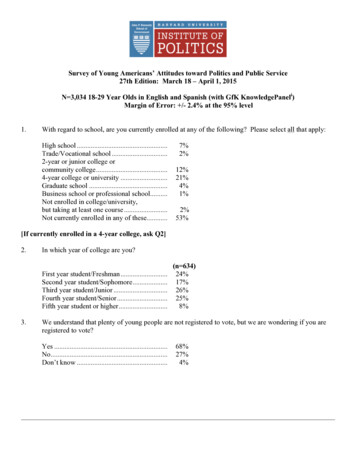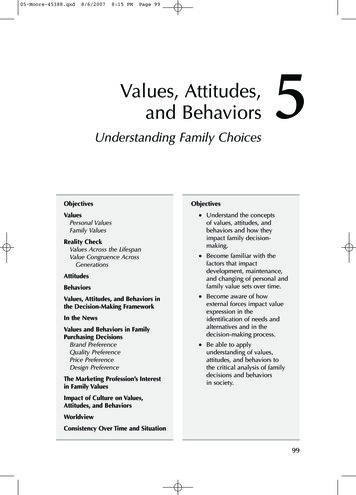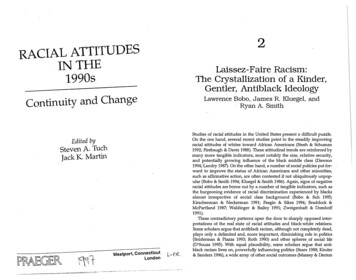
Transcription
RACIAL ATTITUDESINTHE1990sContinuity and ChangeEdited bySteven A. TuchJack K. Martin2Laissez-Faire Racism:The Crystallization of a Kinder,Gentler, Antiblack IdeologyLawrence Bobo, James R. Kluegel, and- Ryan A. SmithStudies of racial attitudes in the United States present a difficult puzzle.On the one hand, several recent studies point to the steadily improvingracial attitudes of whites toward African Americans (Steeh & Schuman1992; Firebaugh & Davis 1988). These attitudinal trends are reinforced bymany more tangible indicators, most notably the size, relative security,and potentially growing influence of the black middle class (Dawson1994; Landry 1987). On the other hand, a number of social policies put for ward to improve the status of African Americans and other minorities,such as affirmative action, are often contested if not ubiquitously unpop ular (Bobo & Smith 1994; Kluegel & Smith 1986). Again, signs of negativeracial attitudes are borne out by a number of tangible indicators, such asthe burgeoning evidence of racial discrimination experienced by blacksalmost irrespective of social class background (Bobo & Suh 1995;Kirschenman & Neckerman 1991; Feagin & Sikes 1994; Braddock &McPartland 1987; Waldinger & Bailey 1991; Zweigenhaft & Domhoff1991).These contradictory patterns open the door to sharply opposed inter pretations of the real state of racial attitudes and black-white relations.Some scholars argue that antiblack racism, although not completely dead,plays only a delimited and, more important, diminishing role in politics(Sniderman & Piazza 1993; Roth 1990) and other spheres of social life(D'Souza 1995). With equal plausibility, some scholars argue that anti black racism lives on, powerfully influencing politics (Sears 1988; Kinder& Sanders 1996), a wide array of other social outcomes (Massey & Denton1Westport, ConnecticutLondon -----····-- -·- -- - -- --- --·-·"
16RACIAL ATTITUDES IN THE 1990s1993), and day-to-day encounters between blacks and whites (Feagin &Sikes 1994).We aim to bring greater theoretical coherence to the hotly debatedquestion of whether the racial attitudes of white Americans reflect lessracism now than was evident 40 -or even 20 -years ago. We argue thatin post-World War II U.S. society, the racial attitudes of white Americansinvolve a shift from Jim Crow racism to laissez-faire racism. As part ofthis change, we witnessed the virtual disappearance of overt bigotry, ofdemands for strict segregation, of advocacy of government-mandateddiscrimination, and of adherence to the belief that blacks are the categor ical intellectual inferiors of whites. The decline of full-blown Jim Crowracism, however, has not resulted in its opposite: a thoroughly antiracistpopular ideology based on an embracing and democratic vision of thecommon humanity, worth, dignity, and place in the polity for blacksalongside whites. Instead, the institutionalized racial inequalities createdby the long era of slavery followed by Jim Crow racism are now popular ly accepted and condoned under a modem free market or laissez-faireracist ideology.Laissez-faire racism involves persistent negative stereotyping ofAfrican Americans, a tendency to blame blacks themselves for the black white gap in socioeconomic standing, and resistance to meaningful poli cy efforts to ameliorate U.S. racist social conditions and institutions. JimCrow racism was at its zenith during a historical epoch when AfricanAmericans remained a largely southern, rural, agricultural workforce;when antiblack bias was formal state policy (that is, separate schools andother public accommodations); and when most white Americans com fortably accepted the idea that blacks were inherently inferior. Laissez faire racism is crystallizing in the current period as a new U.S. racial beliefsystem at a point when African Americans are a heavily urbanized,nationally dispersed, and occupationally heterogeneous population;when state policy is formally race neutral and committed to antidiscrirni nation efforts; and when most white Americans prefer a more volitionaland cultural, as opposed to inherent and biological, interpretation ofblacks' disadvantaged status.Our purpose in this chapter is threefold. First, we seek to clarify theconcept of laissez-faire racism and to distinguish it from related notions,such as "symbolic racism." Second, we assess the record of change inwhites' racial attitudes in the light of our concept of laissez-faire racism.Third, we develop the historical and theoretical basis for understandinglaissez-faire racism as the core thrust of the modem U.S. racial ethos. Ourargument draws heavily on the framework for understanding racial prej udice developed in the work of Herbert Blumer.Laissez-Faire Racism17RACISM IN THE MODERN ERAIs Racism an Appropriate Label?The social science literature has put forward many different definitionsof racism (Chesler 1976; See & Wilson 1988). For our purposes, Wilsonoffers a particularly cogent specification when he argues that racism is"an ideology of racial domination or exploitation that (1) incorporatesbeliefs in a particular race's cultural and/or inherent biological inferiori ty and (2) uses such beliefs to justify and prescribe inferior or unequaltreatment for that group" (Wilson 1973, p. 32). Jim Crow racism readilyfits within this definition of a racist ideological system. The express aimof the ideology was the domination and exploitation of African Ameri cans; it mandated inferior treatment across virtually all domains of sociallife; and all of this was justified on the premise that blacks were the inher ent biological inferiors of whites (Fredrickson 1971). Thus, the ideologywas manifest in institutional arrangements, such as separate schools andvoting restrictions, a variety of collective behaviors, such as lynchings,and readily expressed individual beliefs.It is less apparent that the modem period is as fittingly termed "racist."Race relations and the status of African Americans have changed marked ly in the post-World War II period (Jaynes & Williams 1989). Nonetheless,a strong case can be made that the United States remains a racially domi native society: We believe it appropriate to continue to speak of a racistsocial order in the United States. We use the phrase "laissez-faire racism"to emphasize, however, that the forms and mechanisms of that domina tion are now far more loosely coupled, complex, and permeable than inthe past.The basis for retaining the term "racism" is twofold. First, AfricanAmericans remain in a unique and fundamentally disadvantaged struc tural position in the U.S. economy and polity. This disadvantaged posi tion is partly the legacy of historic racial discrimination during the slav ery and Jim Crow eras. Even if all direct racial bias disappeared, AfricanAmericans would be disadvantaged because of the cumulative and mul tidimensional nature of historic racial oppression in the United States.Furthermore, racial discrimination continues to confront African Ameri cans, albeit in less systematic and absolute ways in its current form.Rather than relying on state-enforced inequality as during the Jim Crowera, however, modem racial inequality relies on the market and informalracial bias to re-create, and in some instances sharply worsen, structuredracial inequality. Hence, laissez-faire racism.The unique structural disadvantage of African Americans is manifest ed in several ways. Despite important relative gains on whites recordedduring the 1940s and the 1960s, the black-white gap in socioeconomic
18RACIAL A1TITUDES IN THE 1990sstatus remains enormous. Bl ack adults remain two-and-a-half times aslikely as whites to suffer from unemployment. This gap exists at virtual ly each level of the education distribution (Jaynes 1990). If one casts abroader n et to sk a bo t "und erempl yment" - that is, falling out of thel bor force entirely, being unabl e to find full-time work, or working fulltime at below pov erty-level wa ge rates - then the black-white ratio inmajor urban areas has risen from the customary 2-to-1 disparity to verynearly 5-to-1 over the p ast two d ecades (Lichter 1988). Conservative esti mates show that young, well-educated blacks who are matched in workexperi ence and other characteristics with whites still ea m 11 percent lessannually (Farley 1984). Studie s continue to document direct labor marketdiscrimination at both low-skill, entry-level positions (Kirschenman &N eckerman 199 ; Tu rn r , Fix, Struyk 1991; Waldinger & Baile y1991) and more hig ly skilled positions ( eagin & Sikes 1994). A growing.chorus of studies mdicate th at even highly skilled and accomplishedbl ack managers encounter gla ss ceilings in corporate America (Fernandez1986; Jones 1986), prompting some analysts to suggest that blacks willnever be fully admitted to the U. S. power elite (Zweigenhaft & Domhoff1991). In contrast to an earli er era, however, black disadvantage in themodem labor market is more likely to flow from informal recruibnentand promotion m ech anis ms than from a blanket racial exclusion o rsegmentation.Judge d a gainst differences in wealth, however, black-white gaps inen:p!oyme nt stat s and earnings seem absolutely palt ry (Jaynes .&Williams 1989; Oliver & Shapiro 1995). Th e average differences in wealths ow black households lagging behind whites by a factor of nearly 12times. For every one dollar of wealth in white households, black house holds have less than ten cents. In 1984 th e median level of wealth held byblack households was around 3,000; for white households, the figurewas 39,000. Indeed, white ho useholds with incomes of between 7 500and 15,000 h av e "high er mean net wor th and net financial assets thanbla k households making 45,000 to 6 0, 000" (Starr 1992, p. 12). That is,whites near the bottom of th e white income distribution have morewealth than blacks near the top of the black income distribution. Wealthis in many wa ys a better indicator of likely quality of life than earnings(Oliver & Shapiro 1995).Blacks occupy a uniquely disadvantaged position in physical space, aswell. D mographers Douglas Massey and Nancy Denton (1989) conclud ed that it akes sens to describe th e bl ack condition as hypersegregation- condition wher m a.group simultaneously scores as extremely racial ly isolated from whites on four of five standard measures of residentialsegregation. As contrasted to th e conditions of Asi an Americans and Lati nos, African Americans are the only group, based on 1980 census data forl arge metropolit an areas, to rank as hypersegregat ed from whitesLaissez-Faire Racism19(Massey & Denton 1993). Although there was some modest decline in thelevel of racial residential segregation between 1980 and 1990 ( arley &Frey 1994), blacks remain hypersegregated ( Denton 1994 . ":711 t is more,.housing audit studies show high levels of drrect racial discnmmation byrealtors and landlords against African Americans (Pearce 1979; Tum.er1992; Yinger 1996). There is mounting evidence that mortgage lenders dis criminate against African Americans, with some of the more careful stud ies showing racial bias even after controlling for financial resources andcredit history (Jackson 1994). Residential mobility has been a critical path way to assimilation into the economic and so ial mains ream for o er.groups (Lieberson 1980). Yet it is dear that Afnc Americans, mdu ingthe black middle class, face formidable obstacles m the search for high quality housing. Such segreg ation is consequential. Neighborhoods mayvary greatly in services, school quality, safety, and levels of exposure to avariety of unwanted social conditions (Massey, Gross, & Eggers 1991).Indeed, a particularly troubling trend is th creasil: ov rl p ongsuburban versus urban location, race, and distinct political Jurisdictions.In the extreme case, a largely black inner city (for example, Detroit) is amunicipal unit separate from the surrounding white suburb areas. Thisis a development that, if it continues, would weaken the b sic structur linterde pendency presumed to exist betw een black and white communities (Massey & Hajnal 1995).The problems of differential unemployment, wage differ nhals, dis parities in wealth, and racial residential segregation place African er icans in a uniquely disadvantaged position in U.S. economy and polity.Adverse market trends, apparently race neutral in origin, have far morepronounced negative effects on African Americans as a result. Over thepast two decades, the U.S. economy has und rgone slow but modest.growth, sh arply rising inequality in wages paid to high- and low-skillworkers (heavily favoring the former over the latter), and a gener llysharp rise in the skill demands for workers made by employers (Danziger& Gottschalk 1995). These general trends, however, appear to have wors ened the relative positio n of blacks in the labor force. The employmentprospects of young black males re lative to comparable white malesdeclined during the 1980s, with the earnings of college-educated blackmales undergoing a particularly sharp drop during this period (Bound &Freeman 1992).Similarly, the uniquely disadvantaged position of African Americansmeans that government policy retrenchments may also have dispropor tionate adverse effects. For example, it appears that the shift in federalsupport for higher education from outright grants and scholarships toloans hit African Americans particularly hard. There was a sharpdecline, both absolutely and relative to whites, in the chances that a blackhigh school graduate would go on to college beginning in about 1979 and
20RACIAL ATIITUDES IN THE 1990scontinuing through the mid-1980s Gaynes & Williams 1989; Hauser1993a). This occurred for both black men and black women and occurredlargely across the class spectrum in the black community. The trend runsagainst other evidence of rising black achievement scores relative towhites and
black racism lives on, powerfully influencing politics (Sears 1988; Kinder & Sanders 1996), a wide array of other social outcomes (Massey & Denton . 16 RACIAL ATTITUDES IN THE 1990s 1993), and day-to-day encounters between blacks and whites (Feagin & Sikes 1994). We aim to bring greater theoretical coherence to the hotly debated question of whether the racial attitudes of white Americans .
